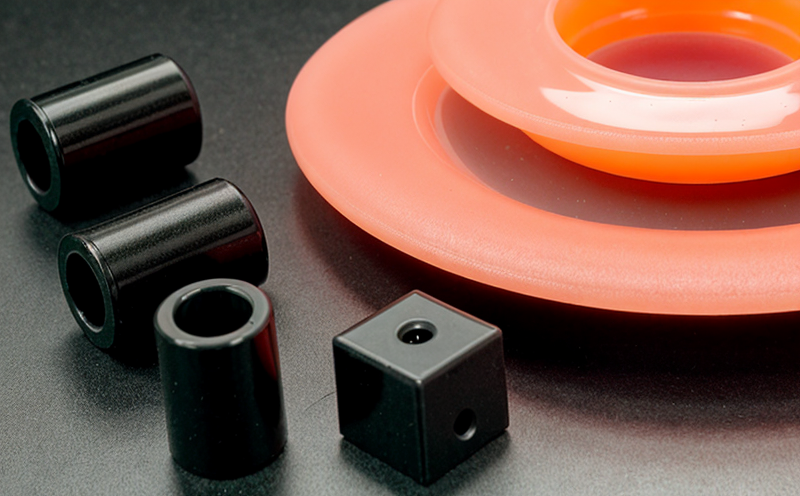ISO 22007 Thermal Conductivity Testing of Plastic Sports Plastics
The ISO 22007 standard establishes the measurement and reporting procedures for thermal conductivity, thermal diffusivity, and specific heat capacity of polymeric materials. This service focuses specifically on testing plastic sports plastics to ensure they meet stringent requirements regarding performance, durability, and safety in various environmental conditions.
Thermal conductivity is a critical property when designing sporting goods that must perform optimally across a range of temperatures and climates. For instance, the insulation properties of ski boots or the heat dissipation characteristics of running shoes are directly influenced by thermal conductivity. Accurate measurement and reporting of these parameters ensure compliance with industry standards and customer expectations.
Testing plastic sports plastics for thermal conductivity involves several key steps. Specimens must be prepared according to strict guidelines provided in ISO 22007, ensuring that the test results are representative of the material's actual performance. The testing apparatus used is designed to provide precise measurements under controlled conditions, typically involving a steady-state heat flow method.
The process begins with selecting appropriate specimens from the batch or production run being tested. These samples undergo rigorous preparation, including conditioning in a specified environmental chamber and cutting to standard dimensions. The prepared specimens are then placed into the testing apparatus, where they experience a controlled temperature gradient across their thickness.
Once the test is complete, detailed reports are generated that include not only the measured thermal conductivity values but also additional data such as the specific heat capacity and thermal diffusivity of the material. These comprehensive reports provide valuable insights into how the plastic will behave under various conditions, enabling manufacturers to make informed decisions about their product design.
By adhering strictly to ISO 22007 guidelines, our laboratory ensures accurate and reliable testing results that can be trusted by quality managers, compliance officers, R&D engineers, and procurement teams. This level of precision is essential for maintaining high standards in the production of sports and leisure plastics, where even small variations in thermal conductivity can have significant impacts on product performance.
Our commitment to excellence extends beyond just meeting the requirements set forth by ISO 22007. We continuously strive to stay at the forefront of technological advancements in materials testing, ensuring that our clients receive up-to-date and relevant information about their products' thermal properties.
Applied Standards
The ISO 22007 standard is widely recognized as the gold standard for measuring thermal conductivity, diffusivity, and specific heat capacity in polymeric materials. This service specifically applies this standard to plastic sports plastics, ensuring that manufacturers comply with industry best practices.
- ISO 22007-1: General requirements for testing the thermal properties of polymeric materials.
- ISO 22007-2: Determination of thermal conductivity and thermal diffusivity in the steady-state by transient plane source technique (TPS).
- ISO 22007-3: Determination of thermal conductivity and thermal diffusivity in the steady-state by hot disk method.
The use of these specific ISO standards ensures that our testing methods are both accurate and consistent with international norms. Compliance with such standards is crucial for manufacturers aiming to produce high-quality, reliable sports plastics that meet global market demands.
Scope and Methodology
The scope of this service includes the detailed measurement and reporting of thermal conductivity, diffusivity, and specific heat capacity for plastic sports plastics. Our methodology adheres strictly to ISO 22007 guidelines, ensuring that all tests are conducted in a controlled environment using state-of-the-art equipment.
Specimens undergo rigorous preparation before testing, including conditioning at specified temperatures and humidity levels, followed by precise cutting into standard dimensions. The specimens are then placed into the testing apparatus where they experience a controlled temperature gradient across their thickness. Data collection occurs over time as the material reaches thermal equilibrium.
The results of these tests provide manufacturers with crucial information regarding how well their materials perform under different environmental conditions. This data can be used to optimize product designs, improve manufacturing processes, and enhance overall quality control.
Our team of experienced technicians uses advanced instrumentation capable of providing highly accurate measurements. These instruments are regularly calibrated against international standards to maintain precision throughout the testing process. The resulting reports include not only the measured values but also detailed descriptions of the specimen preparation and test setup.
By following this comprehensive approach, we ensure that every test conducted adheres strictly to ISO 22007 guidelines while providing valuable insights into the thermal properties of plastic sports plastics. This level of accuracy is essential for maintaining high standards in the production of quality sporting goods.
Environmental and Sustainability Contributions
- Reduced Waste: By ensuring that plastic sports plastics meet strict thermal conductivity requirements, manufacturers can reduce waste by producing more efficient products. This leads to longer-lasting items and decreased resource consumption.
- Eco-Friendly Materials: Testing helps in selecting eco-friendly materials with better thermal properties, reducing the environmental impact of manufacturing processes.
The accurate measurement of thermal conductivity plays a vital role in promoting sustainable practices within the sports industry. For example, manufacturers can design shoes that dissipate heat more effectively or create equipment that maintains optimal temperatures during use. Such innovations contribute positively to both performance enhancement and environmental responsibility.
Furthermore, understanding how different plastics behave under varying conditions allows for better recycling strategies. Knowing which materials degrade faster in specific environments enables manufacturers to choose those suitable for certain applications while avoiding others prone to rapid breakdown.





